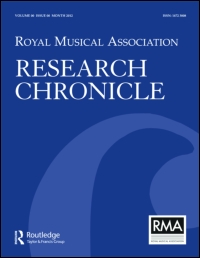Article contents
A Seventeenth-Century Source of Ornamentation for Voice and Viol: British Museum MS. Egerton 2971
Published online by Cambridge University Press: 01 January 2020
Extract
Many aspects of the performance of early seventeenth-century monodic song remain a mystery. On the basis of the musical notation alone, we might be tempted to wonder, as did Charles Burney,
… how pleasing effects could be produced by such simple, unadorned, and almost unaccompanied melodies …. the expression of the Music of this period in Italy is so entirely lost, that, like a dead language, no one is certain how it was pronounced.
- Type
- Research Article
- Information
- Copyright
- Copyright © Royal Musical Association, 1971
References
1 A General History of Music (London, 1776–1789), IV, 136.Google Scholar
2 See Duckles, Vincent, “Florid embellishment in English song of the late 16th and early 17th centuries, ” Annales Musicologiques, V (1957), p. 332.Google Scholar
3 This page has been discussed in an article by Thurston Dart, “Ornamentation Signs in Jacobean Music for Lute and Viol, ” Galpin Society Journal, XIV (1961), 30–33, though he does not relate the table to the actual signs used in the manuscript.CrossRefGoogle Scholar
4 British Museum Catalogue of Additions to the Manuscripts, 1916–1920, (London, 1933), p.306.Google Scholar
5 Jones’ Ultimum Vale, or the Third Book of Ayres of 1. 2. and 4 Voyces was printed in 1608. The copy mentioned by Warren is the only surviving copy, now in the library of the Royal College of Music.Google Scholar
6 British Museum Catalogue of Additions to the Manuscripts, 1916–1920, (London, 1933), p. 306.Google Scholar
7 Dart, op. cit., p. 31Google Scholar
8 Robert Dowland's Musical Banquet (1610) included 4 Italian songs, 2 of them (“Amarilli mia bella” and “Dovrb dunque morire”) by Caccini. In addition to the 5 Italian songs (3 by Caccini) in Egerton 2971, 18 of the Italian songs in Tenbury 1018–19 are by Caccini, among them “Amarilli.” Several English musicians studied in Italy early in the century, including John Cooper (Coperario), who returned ca. 1604–1605 and probably introduced the Italian monodic style in England. Angelo Notari, an Italian musican who came to England early in the century, published a collection of Italian songs, Prime Musiche Nuove à 1. 2. e 3 voci (London, Guglielmo Hole: 1613).Google Scholar
9 Froiii his foreword, “To the understanding reader”.Google Scholar
10 See Spink, Ian, “Playford's ‘Directions for Singing after the Italian Manner'”, Monthly Musical Record, LXXXIX (July-Aug., 1959), pp. 131–2.Google Scholar
11 Playford, An Introduction to the Skill of Music, 1655 (167 edition, page 42). Caccini, Le Nuove Musiche (1602): “Sono adunque alcuni, che nell intonazione della prima voce, intonano una terza sotto. …”Google Scholar
12 page 12.Google Scholar
13 Page 79.Google Scholar
14 Manchester, Henry Watson Music Division of the Central Library; see Cowling, Elizabeth, “A manuscript collection of viola da gamba music”, Viola da Gamba Society Journal, I (1964), 16–29.Google Scholar
15 Pittsburgh, Pennsylvania, private library of Theodore M. Finney, the Mansell lyra viol tablature; see Traficante, Frank, The Mansell Lyra Viol Tablature, unpubl. doctoral dissertation (Univ. of Pittsburgh, 1965).Google Scholar
16 Trinity College, Dublin, Ms. D.I. 21.Google Scholar
17 The same tuning appears in the Manchester gamba manuscript as the third of 22 tunings, and is called “lyra waye”. For the transcriptions the following tuning was assumed: C, F, c, f, a, d'.Google Scholar
- 1
- Cited by




